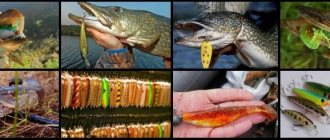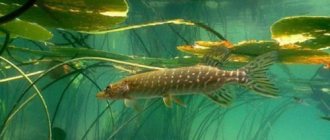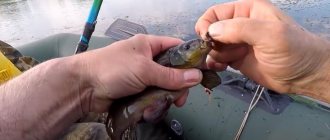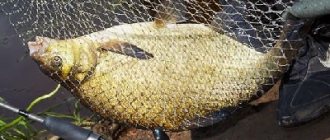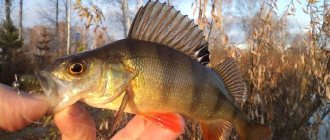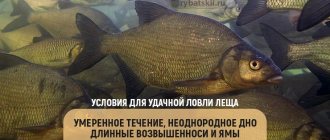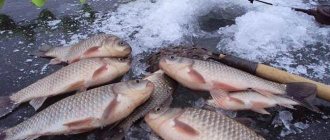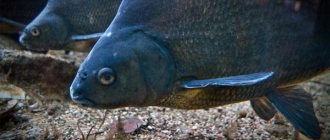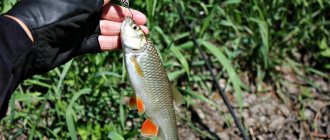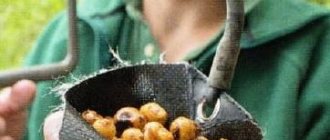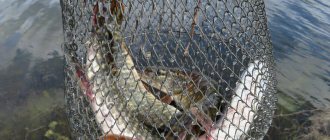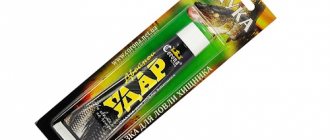Specifics of pike fishing on micro rivers
Most representatives of the carp family prefer to spawn in small rivers. And pike is no exception. After the fry appears, the adult fish returns back to the large body of water, and small individuals remain in the spawning area. The toothy predator also swims into micro rivers in order to fatten up, since such water areas contain a lot of easily accessible prey, especially bleak, roach and chub. In such conditions, the pike manages to ambush and attack passing prey. The routes of its movement and stops may not change for years.
However, the large predator refuses to visit small rivers, because... she becomes very cautious, and larger fish appear on her daily menu. Trophy representatives of the species are accustomed to stopping at great depths with a comfortable water temperature and a sufficient supply of oxygen. They also need the ability to quickly reach shallow water areas. Most often, fishermen catch individuals weighing 1.5-2 kg on micro rivers.
In the summer, the pike spends less effort than in the cold season, so before each feeding it carefully considers its actions and only after that it goes in search of the fry. Due to the high transparency of the water, it becomes difficult to catch it - the fish sees everything and moves away from any sources of danger.
When fishing on a small river, it is important to take into account a number of rules for moving along the shore. In most cases, spinners buy a wading suit and go into the shallows through the windows among the vegetation. However, the pike has already become accustomed to this behavior and has become more cunning. And not everywhere you can go into the water due to changeable terrain, muddy bottom or great depth.
If possible, it is better to use a rubber boat. But in any case, fishing should be carried out upstream with an examination of the upper areas. Staying quiet and careful on a small river can be problematic. The fisherman also needs to hone his casting technique and learn how to make them as accurate and “subtle” as possible. The use of a floating device is not always justified, since sometimes the banks are impassable.
Pike fishing in a micro river: returning to the river of childhood
After a busy summer of work, it's finally time for vacation. The “generous” authorities allocated only a week, so deciding where to go was not easy.
I didn’t want to go too far, and I didn’t have much time, so I decided to go to the Nizhny Novgorod region, meet with friends and visit the shores of the Volga, familiar from childhood, and another small river, which became for me a kind of alma mater in understanding the art of sport fishing.
After an unsuccessful search for an asp in the vastness of the Volga, I spent the last four days of my vacation on my river. I would not like to name it, because there is already enough fishing and poaching pressure there. I will only say that it originates from peat bogs, and flows through an impassable forest thicket. The color of the water, as expected, is dark brown, and the fish population is very diverse.
I haven’t been to this river for six years, and yet it was here that I learned the basics of fishing with a float rod, donka... My first spinning experiments took place here, the first pikes and perches were caught on spoons and spinners. Now these are all warm memories, but fishing with live baits has remained somewhere in there, in childhood.
But the question of whether, after so many years, with a spinning rod in my hands, I could understand this river in a new way, pick up the key to the predator and find the trophy, excited me for a long time. This is where the return to the river of childhood began, which I want to talk about today. At the same time, I will share with readers my experience and thoughts about finding fish in difficult conditions.
Before starting the story about the fishing itself, I would like to dwell on the nature of the reservoir, since it determines the choice of gear and equipment.
The river we are talking about is small. Its width rarely exceeds 10 meters. It meanders through forests, so the water in it is always cold, and the riverbed is very snaggy. Tree debris and vast overgrown areas are not uncommon there, and along the banks there are windbreaks and ravines with nettles taller than a man. It was in these conditions that I had to look for fish. And given that fishing took no more than three to four hours a day, the organization of the arsenal had to be approached as responsibly as possible.
We had to move a lot along the difficult banks, so the choice was made in favor of a small (20 liters) backpack paired with a light belt bag for bait.
As for the spinning rod, ideally I saw a short, light, but at the same time quite powerful all-rounder with a length of no more than seven feet, designed to throw loads of up to twenty grams. A solution was found quickly. The Norstream Rooky RKS-602ML caught my eye. With a height of 183 centimeters, this rod has a test for lures of 4-18 grams and is positioned by the manufacturer as a series for twitching and jigging.
It should also be noted that this is the most “popular” class. The retail price on the company’s website for this instrument does not even reach the 2,000 ruble mark. Therefore, it was even more interesting to walk through windbreaks with this spinning rod and see how an inexpensive model of a domestic brand would cope with difficult conditions. I didn’t have any mistrust of Rooky, because I had long ago noted that the guys from Northstream know how to make decent, inexpensive “sticks,” but there was some desire to rigorously test low-budget-class tackle for professional suitability.
With coils and cords the situation was more complicated. What was needed was the most powerful, reliable, but at the same time light and capacious spinning rod, capable of confidently working with a medium-thick line, and in which case it would allow you to “press the pedal” and quickly move the fish, including decent ones, away from snags and other dangerous obstacles . According to the Shimano scale, a minimum weight of “four thousand” suggests itself here. Vanquish or something from the Ci4+ generation would be ideal, but due to my dislike for these series, my choice fell on the proven Shimano 09' Exsence Mg 4000S. A rather rare “toy”, with a weight of 260 grams and with a medium (5.2) gear, it seemed to me an ideal option. Being lighter than the 10th Stella-4000, it has all the qualities of a high-quality reel necessary for difficult conditions. And it’s nice to hold it in your hands, no matter what you say!
As for cords, I am an adherent of the theory that it is better to buy an inexpensive decent cord and replace it a couple of times a season than to spend several thousand rubles on a “top thread” and then worry about its safety. So lately I've been using the Norstream Absolute Game X8 cord for these conditions. This is a fairly smooth eight-vein, pleasant to the eye and noticeable in any conditions light green color. I like it because it perfectly holds the breaking load at different nodes and passes through any rings very well - it has no lack of “volatility”. The only downsides include not the highest abrasion resistance and a fairly rapid loss of color in the work area. But this is compensated by the retail cost of less than 900 rubles for a 150-meter unwinding and the ability to cut off the last half-meter or meter when tying without regret.
In terms of cord thickness, the ideal number would be 1.2. The river, even at the time when I started fishing here, was not replete with trophies, but cramped conditions make even a kilogram pike a worthy opponent. However, at one time the reservoir was distinguished by a large number of ide and decent perch, so I still put the box with light baits in my backpack, and took the #1 cord, relying on the strength of the Northstream “Absolute”.
So, the first exit to the river. Yes, the places of my childhood have changed. New piles of snags, different paths, and the river itself seems to have become at least half the size! Or maybe it's me who has grown up?
I start right from the village. The first cast of the Mepps Comet number three, two turns of the reel, someone flies out of the thickets like an arrow and hits the spoon. And now I’m dragging a lively pike weighing 700 grams through the grass.
Yes, unexpectedly! But they say there are no fish...
After a short photo session, I release the pike back into the peat water and, inspired by this start, I move on. About thirty meters later I find an interesting area with grass and a quiet current. I put on a pink Jackall Tricoroll and hook a pike on the second retrieve. This one is nicer. It fights desperately, collecting grass and snags on the cord. But Rooky surprisingly easily copes with the lively spotted one, and now I’m reaching for the lipgrip to the open mouth. She grabbed it carefully, hanging on one hook of the tail tee... Jerk! And the fish runs away.
It's not even offensive, but instructive. And the size is good for a river, there was definitely a kilogram there. I note the place and move a little higher.
Literally after a few postings a small toothy one misses. I can’t catch it, so I move on. I go around the stormy riffles and stop at a fairly long interesting section. I'm sorting through the baits - silence. I decide to go a little downstream and explore the snags. As usual, the most promising places remain silent. But in a shallow area, where there are only three blades of grass and a couple of water lilies among the shelters, the obvious “bummer” happily grabs the “acid” FishyCat Tomcat SSR. Fishing is not easy, the bank is steep and overgrown. I lift the fish with the rod.
Rooky copes, the cord also holds. A photo shoot, a wag of the tail... Not bad at all. After that, another pike gathering and nothing more.
Such an ambiguous first day. Five bites, two tails... Surprisingly, neither ide nor perch are visible at all. So, tomorrow we’ll aim for the pike and won’t waste any time.
The second day turned out to be less interesting. With a smile, I watched as a 200 gram pike furiously bit into the back of the 130th Jackall Rerange for half a minute, saw the attack of a 700 gram pike on Pontun’s “Preference”, went through a lot of promising places, went through about fifty baits..
Desperate, I uncover my secret weapon - the Jackall Magallon hidden in my backpack. Lately I've been trying not to fish with this bait. Once upon a time I found myself in a situation where, apart from the Magallons, I had nothing pike with me, but I did have pike. Over the course of a week, I tried all the variations of this bait, all the nuances of presentation, game, and reaction of the fish. After that, the legendary jackal compound catches better for me than any other bait in this size. It seems to me that mowing down the entire river with him is not a problem. And the only thing that can somehow save underwater inhabitants from this “incarnation of pike death” is the very low efficiency of hooking with native tees. But you have to give the fish at least some chance...
I want to get away from zero, but I still hang up Magallon. As expected, on the second retrieve I catch a small sad “string”.
And after another three casts I persuade a “zakiloshnik” among the snags, which leads into the very support. You have to get it by force. The rod bends from the handle, but it still pulls out a pike from a solid snag.
Surprisingly, both bites were not empty. The fish was caught. I hide the “acid” Magallon as far as possible so that I don’t get it again. This concludes the second day.
There is no mood. I'm doing something wrong! Just what exactly? Four bites, two fish... And those don’t really count, because they were caught with an openly “poaching” fish. Tomorrow we need to seriously change our approach!
I started the third day with a thorough reflection on my mistakes. The thought that the pike was attacking from some unobvious places haunted me. And where, according to all external signs, it should be, it is not. Or…? Or am I giving her the bait wrong?
First, I completely went through the entire arsenal. I removed half of the “extra” baits (including those same 113s), added rubber and weights. I’ve never fished with a jig in rivers like this, but why? I think everything in stereotypes from five years ago! A light gliding bait that falls into snags and knocks on branches. That's what she needs! And if you're afraid of snags, don't catch them in the forest!
I decided to move away from the previously fished places, experiment, go through the snags first, and on the way back, break through the same places with a jig.
I put a bright orange Jackall Scissor Comb 3.8″ on a large offset hook with a 5 gram weight. The first snag, and immediately after the bait touches the branch, a blow follows. The pike is small, but the fact remains.
In order to eliminate the factor of chance, I move to the neighboring area and again from the second retrieve I catch a small bee-eater. It works!
Literally a couple of meters to the right I persuade the third!
This means that she needed it! And then - more! What a slob I was, I had yet to understand. The very first decent submerged snag, the bait falls into the thickness of the branches, a turn of the reel - and a strong blow.
Hook... And nothing! There is only a bitten piece of fluorocarbon leash in your hand.
Like this? I’ve been catching pike with a 0.45 fluorocarbon leash for about four years now! Not a single cut, and pulled out trophy pikes! And here…
I quickly bandage it, deciding that, most likely, the fluorocarbon was simply frayed earlier, and I didn’t look. I'm moving on. Snag again, cast, turn-pause, turn-pause... Bang! Sweep! Cut!
I can't hide my annoyance. To yourself, first of all. They also devoured the last correct Scissor Comb... I’m finishing my fishing. The mood is below the waterline.
I start the fourth and final day with a complete shake-up of the contents of the car. Naturally, hoping for fluorocarbon, I didn’t take a single package of steel or titanium leaders with me. After going through all the bags, boxes and glove compartments, I finally find 4 string leashes. Not bad already. You can go to the river. This time I go to an area far from the village.
But what to do with the fact that yesterday I donated the last correct bait for pike piercing? But even here a solution was found. We needed a voluminous and, moreover, bright elastic band. Fish simply won’t see any “natural” colors, much less variations on the theme of machine oil, in dark peaty water. What bright things do we have? Only three-inch carrot Jackall Wobbrings. But they are skinny and it will be difficult for fish to see them. Okay, stop. And if..?
I put two pieces on an offset hook at once. One as usual, and the second on the forend. It turns out to be a kind of frog turned sideways. Okay, let's try it.
On the second cast into the snags under the opposite bank - “Khryas!” The next fishing began with pike being pulled out of snags and dancing on the tail. Not without difficulty, but quite confidently, I “park” the spotted beauty to the shore, and take it with a lipgrip the third time. And here there is already an obvious one and a half kilograms. Yes, it’s been a long time since such a fish brought so many emotions.
I take a photo, release it, and catch it further. Literally five meters later there was another blow. Empty. I throw it there - hit and go. The third cast - blow, caught it! Less than a kilo, but lively!
Another 5 meters, and there’s another blow among the water lilies! Another “okolokoloshnitsa” chews a spike from the “Wobbrings” and tries to go into the grass. Not so! The younger Rooky easily lifts the fish from the cover and throws it onto a steep bank.
Super! Three tails per ten meters of river!
To be honest, I used to think that one pike here occupied about thirty meters of the river. Nothing like this! There are much more fish here, but not all of them are equally active.
I move a little further, storming the coastal windbreak. Out of the corner of my eye I notice a black tail crawling away from under my feet, but I don’t attach any importance to it. After a couple of tens of minutes I understand that I can’t walk anymore. My legs hurt and feel weak, and my head is foggy. Nausea, some kind of sharp malaise. I stop, look at my legs, and they are swollen and there are two wounds on each, from which blood is oozing... Having put the facts together, I gather my last strength into a fist and begin to move through the pain. Move towards the village. I understand that in the complete absence of mobile communications and far in the forest, I won’t last long without help and I need to get to people as quickly as possible.
I don’t want to describe the further hell on the verge of losing consciousness with walking across rough terrain on aching, stiff and swollen legs, as well as what happened to me next, until long after midnight I left the hospital, bandaged and injected with everything possible , according to the Viper program.
I almost had my last fishing trip. The fact that I got out and held on until qualified (well, how can I say...) help is a miracle! And boots should probably be worn when fishing, even in the heat.
Unfortunately, we couldn't catch any more. Then there was painful rehabilitation and time to comprehend this fishing. But overall the trip turned out to be instructive and interesting. I didn’t catch mountains of fish, but I found the key to it, and all the experiments brought results.
I must admit that the gear I used coped perfectly with the task I set for it. Norstream Rooky has never let me down. All types of baits (wobblers, jigs, spinners, spinners) the spinning rod worked with a bang. Sensitivity is more than enough, power too. It feels comfortable in the hand, nicer than the middle class Northstream like Gravity or Dynamic III. The build quality is also quite acceptable. And the safety margin is worth it! Now I know that if I come across a trophy fish, I can be completely confident in this medium light. But it’s probably not worth taking a lighter “stick” for such fishing.
There were no questions about the cord either. He not only withstood all the survival in a remote snag, but also helped save a bunch of baits by tearing branches from trees and unbending hooks. However, if your line number starts from zero, then there is nothing to do with it on such rivers. Number one is the minimum, but it can be thicker, it won’t be superfluous.
As for baits, next time I will take more different large and bright rubber for such fishing, but I will reduce the number of other baits to a minimum. Still, a jig is more effective at collecting pike in such reservoirs, and the ability to cast it into the very wilds is very helpful when the fish are not so active.
Jackal's rubber bands have finally been caught. It looks like they will settle in my arsenal tightly and for a long time, now I believe in them.
I hope that they will still give me a rest break, and before the freeze-up I will still have time to return to this river and fish for toothy ones during the period of its maximum activity. Now I understand the principle and know that not a single, even the most unobvious, place where a predator is supposed to stay should be left without attention. And there are much more fish in the “river of childhood” than it seems!
I wish everyone to be careful when fishing, catch, release and catch again!
See you again!
Iron Andrey
Share
Fish Search Tactics
The key criterion for choosing a place for fishing is the condition of the food supply. There is one principle in spinning pike fishing: where there are small fish, there are pike. To prevent yourself from wasting time and effort on unsuccessful casts, you need to find a promising point in advance and determine the location of the fish. The predator prefers areas with favorable water temperatures and an abundance of easily accessible food. In the summer, she likes to set up ambushes near streams or springs, along with which insects, caddis flies and other food end up in the river. Pike can also be found near steep banks, which are washed by currents and are subject to landslides or landslides. This is due to the fact that nutrients and living organisms enter the water along with the soil. They attract the fry, which, in turn, arouses the interest of the predatory inhabitants of the reservoir. Often small fish form schools below rapids and riffles or at points with fast currents, where the water is enriched with nutrients and oxygen. Pike can be found nearby in quiet pools or holes overgrown with vegetation. As the water warms up to 19-22 degrees Celsius, the toothy hunter loses activity and rarely goes hunting. Now it moves to cool springs and stays at depths of 2.5-3.5 meters. But despite its sluggish behavior, the pike does not refuse the opportunity to pounce on passing prey. Fishing on a micro river becomes most difficult during the hottest period of the year, when the water level in the reservoir drops and the temperature exceeds 22-25 degrees Celsius.
You need to look for pike at a depth in the lower horizon near trees, snags and steep banks with narrow windows among the thickets. The main thing is that the place is well shaded and closed from outside access. Often, in hot weather, the predator does not leave its camp sites at all, so the fisherman needs to pay special attention to promising points. On rivers with fast currents, many springs and low water temperatures, pike remains active even in the summer heat. In such water areas, it settles in the most unexpected places and behaves unpredictably. However, the spinning angler must be guided by generally accepted fishing principles, casting the bait along vegetation thickets, shallows and depressions on the bottom. When examining channel channels, artificial fish are carried out in such a way that they are sent from the shallows to the deep areas. Wiring along the upper or lower edge of the edge is often highly effective.
On micro rivers you can find places with a sandy bottom, but the pike stops there only in the morning or when there is a reverse current. If there are snags nearby and schools of fry are present, there is no need to practice dragging along the bottom, as this can lead to breakage of the equipment. If there are no holds, inspection of all horizons is allowed. To study the specifics of the bottom topography, eliminating snagging, it is recommended to use a non-snacking installation with an offset hook. If the pike stays in areas remote from the current and settles in quiet backwaters, it becomes very cautious and sensitive to any unusual sounds. Having noticed a potential danger, it will immediately hide in the depths and stop responding to the bait. Even on a small river, a predator can be frightened by a slap from a spinner that has hit the water. To prevent spooking the fish, you do not need to use large baits and heavy weights.
Often, anglers are faced with a situation where they discover a promising window among the vegetation and believe that after casting the bait a quick bite awaits them, but all expectations turn out to be in vain. In most cases, this is due to the inability to perform an accurate cast. Therefore, a novice spinning angler needs to carefully work out the casting technique and learn how to accurately deliver the equipment to a hard-to-reach place.
When examining shallow water areas, pike can be identified by loud splashes. Under these conditions, it is permissible to use larger baits; at this moment, the fish are not afraid of outside sounds, because she publishes them herself. The cast is made either to the splash site or at a short distance from it. Having found a promising area, you need to carefully fish it. If there is no positive result, you will need to change the bait or wiring technique.
How to fish on micro rivers correctly: useful tips for fishermen
At first glance, it may seem that fishing in small rivers and streams is a completely futile activity. How can big fish live here? But sometimes small bodies of water bring real surprises. They manage to catch real trophies, of course, with due effort. In this article we will tell you how to succeed in this exciting form of fishing.
Small rivers are bodies of water up to 10 m wide and narrower, sometimes resembling ordinary streams, often shallow with shallow depth. In such rivers, fish most often stay locally in places with greater depth than the general one. To find such places you sometimes have to walk quite a distance. But when you find them, the river will be able to please you with a wonderful catch, because very rarely does anyone try to catch something here.
When catching a predator, a jig with a small weight, usually up to 4 grams, and shallow minnow wobblers are most often used. Sometimes shallow-reaching crank wobblers and light spinner spoons are used. It should be understood that sometimes there may simply be no interesting fish in a river, for example, a stream where only chub and perch live, but no pike. Therefore, information obtained from local fishermen or in the appropriate Internet resource dedicated to a particular body of water is often very useful.
Small rivers are best visited in autumn and spring, when there is not much vegetation yet; in summer, most micro-rivers resemble impenetrable jungles. That is why, for greater ease of movement in this fishing, short spinning rods up to 2.1 m long are used.
Since the casting range fades into the background, the maximum thickness of the braid is used, allowing you to not stand on ceremony with the fish and calmly break through the hooks, but for catching cautious fish, such as chub, a fluorocarbon shock leader is often used. A power coil is required, with a low gear ratio; multiplier coils are often used.
Also, you need to pay due attention to your equipment; you will need reliable and high-quality equipment. You need high, comfortable trekking boots that protect your feet from dislocations and damage, and also prevent snake bites.
Useful tips from Konstantin Kuzmin:
Among other things, be aware of the danger of falling into beaver pits and encountering nuisance insects such as bees, wasps and ticks. On long-distance fishing trips, which involve small micro-rivers, the issue of transporting and preserving clean drinking water often arises, so instead of a small bottle and flask, you can consider a voluminous and convenient back hydration pack, of which there are a large variety on the market now. Such a device will be very convenient and an indispensable aid in your fishing, hiking and tourism.
To set up a comfortable rest stop, you will need an inflatable pillow, a foam mat and a convenient compact gas burner. It is better not to skimp on equipment; it will provide sufficient comfort while fishing and even with a modest catch it will not spoil the impression of going out into nature.
Fishing on micro rivers is an exciting activity that requires effort. But successful fishing in such conditions will definitely not leave you indifferent. At least once a season you definitely need to go to such bodies of water. This will add variety to your fishing activities and allow you to develop in such a difficult craft as fishing.
Preparing gear for a micro river
When fishing for pike on the shore, you need to use a short spinning blank 1.8-2.5 meters long. Its action should be fast or ultra-fast, and the test range should be 5-15 g. Longer models are not needed, since they prevent the angler from making accurate casts and feeling sluggish bites from prey. It is better to use models weighing 5-10 grams as bait. The reel must be inertia-free with a large gear ratio. This is necessary in order to quickly reel in the bait without allowing it to end up in snags or vegetation.
When using rigid forms, it is necessary to choose monofilament fishing line, because... it has good stretchability and can absorb the jerks of ferocious prey. If the spinning rod belongs to the “light” class or has a parabolic action, you need to choose a rigid braid - with its help you can perform precise hooks. The diameter of the braided thread can be 0.15-0.18 mm. Instead of classic tees installed on a factory bait, it is better to use triple models made of thin wire. Models from the company OWNER ST-21BC series “L” enjoy good reviews. They demonstrate a long service life and the ability to instantly pierce the hard jaw of a toothy predator.
Often the main catch of a fisherman on a micro-river is grass pike, which grows to 300-700 grams. However, conscientious spinners release such prey so that it gains weight and reproduces. In order not to injure it, eliminating the possibility of bites from small individuals, it is better to use hooks numbered 9-10, rather than tees numbered 5-6.
Selection of baits
In the summer, pike's metabolic processes are suspended, so it is more selective in its choice of food. If the angler managed to find a good bait, the bite is guaranteed; if not, fishing can turn into a waste of time and effort.
If there are a lot of small pike in a reservoir that attack everything that is in sight, any bait can be used. Among them:
- Streamers.
- Flies.
- Wobblers.
- Vibrating tails.
- Crustaceans.
In mid-July, when the vegetation becomes high and impenetrable, fishing with the listed baits with a float becomes more difficult. Instead, weighted streamers or flies are used, reminiscent of a light jig with feathers.
When choosing a spinner, wobbler or vibrotail, it is important to pay attention to its color. It should resemble real prey as much as possible and be familiar to pike.
In search of catchable baits, various experiments are allowed. Sometimes fish are attracted to the most unexpected products that have a strange shape and design.
Fishing with live bait
The traditional method of catching pike is live bait fishing using float gear. The following elements are used for the manufacture of equipment:
- Main line.
- Float.
- Leash and hook.
- Sinker.
As a blank, you can use a fairly rigid model that can make long casts and cope with the aggressive jerks of a resisting pike. Such rods are called pike rods and are sold everywhere in fishing stores.
The optimal length of a float rod is 6-7 meters if there is no reel, and 4-5 meters if there is one.
The optimal diameter of the fishing line is determined by the size of the expected catch and the size of the baitfish. But it should be as inconspicuous and soft as possible so as not to make the pike wary. For most fishing conditions, an option with a diameter of 0.20-0.25 mm is suitable. And since pike can bite through the fishing line, the angler should add a good leash like “steel silk” to the basic equipment.
When fishing for pike using a match rod, you can choose a thin braided thread. The presence of an inertia-free reel will allow you to dampen strong jerks and competently pull fish out of the water.
The length of the main line must exceed the length of the rod (if fishing is carried out without a reel). Otherwise, casting may become difficult, especially in strong winds.
It is better to use small fish, 8-10 cm in size, as live bait. In order for it to remain active for a long time, it is placed on a hook by the gill or fin. The best live baits are perch, roach, crucian carp, minnows and ruffs. You should not choose valuable representatives of the ichthyofauna, which include chubs, asps, pike perch and fish from the salmon family.
The size of the live bait is an important factor on which the entire result of catching pike on a micro-river can depend. The optimal value is 8-10 cm, but deviation in any direction is allowed if necessary.
Typical chub sites on a microriver
In July and August, on the micro rivers where I fish (and these are the Iznair, Kiestendeyka, Arkadachka and Biryuchka), aquatic vegetation grows. Algae during this period constitute the main diet of the chub, but this does not mean that the fish completely refuses insects, worms and caddisfly larvae falling into the water. Moreover, in juvenile chubs, predatory instincts are not as pronounced as in their older counterparts.
Large individuals are infrequent visitors to shallow water; they prefer riffles, washed-out banks, deep holes and pools. Now let's talk in more detail about each of these places.
Microroll. It would be incorrect to use the term “riffle” in relation to my micro-rivers, because by “riffle” we mean “a strong current and a vast shallow area with rocky or sandy deposits.” For a micro-river, the word “micro-riffle” is better suited.
It's almost the same thing, but not on such a large scale. The chub comes to the micro-riffle closer to noon. In the morning hours it is better to pay attention to other places. In this area, I most often use medium-depth cranks and heavy-core spinners.
Pool. It is in the pools that you can catch the largest chubs. Usually at the bottom of the pools there are snags - a real home for the redfin. In the morning hours, the fish hides in these snags, and closer to lunch they rise to the surface.
Until the chub reaches the surface, it can be caught using a deep-diving wobbler, but when the sun begins to burn, the bighead loses activity and stands motionless at the surface. In this case, you will not be able to seduce the fish, no matter what tricks you resort to. There is an option to use a small walker, but the effectiveness of such an idea is 50/50.
Pit. Chub are found in the pits both in the morning and at lunchtime. That's why I think this place is the most versatile. Closer to lunch, the chub leaves the pit, and it is important for him to control what happens at the exit from it. Most often, when fishing in pits, I use “micro-oscillators” weighing 2 - 2.5 g and small walkers: in the morning, spinners work great, and when the chub comes out of the pit, it is easier to catch it with a surface bait that imitates an insect that has fallen into the water.
A washed-out bank with overhanging branches. This is a classic chub spot. And even if you didn’t manage to catch a big-headed fish here, don’t doubt that it is here. Most likely, you are doing something wrong. It is very important to move the bait parallel to the washed-out bank. And this is where you need casting accuracy.
